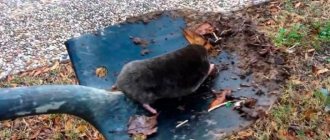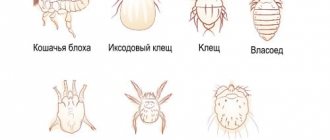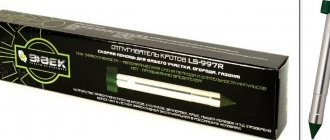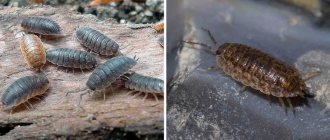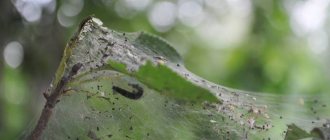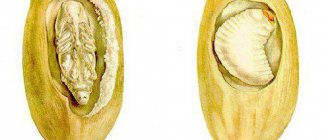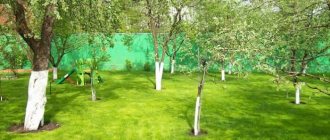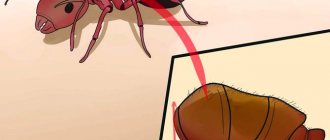Description and appearance
The American white butterfly is a member of the bear family. This insect is not large in size, its body length barely reaches 10-16mm. Its wingspan is 25-35 mm. In terms of its structure, the moth is not particularly different from other butterflies. A characteristic feature is the white color of the wings and body with rare black or brown dots. The antennae are dark with a light coating; in males they are comb-like, in females they are thread-like.
The body of the American white butterfly consists of three sections: head, chest, and abdomen. The insect also has three pairs of segmented limbs. The head is inactive, rounded with a slightly flattened nape. The eyes are convex and cylindrical. They occupy most of the lateral surface of the head.
The abdomen of these moths is elongated and cylindrical, covered with light down. In female American white butterflies that have not yet laid eggs, it has a greenish tint.
The pest has two pairs of wings. The rear ones are smaller than the front ones. They are covered with flat scales of various shapes, which are penetrated by transverse and longitudinal veins.
The eggs are greenish, but later acquire a dirty gray tint. The caterpillar larvae of the American butterfly are yellow in color when they appear. In this case, the thoracic region of the head and limbs have a darker shade. On the back of the larva there are 2 rows of small black and yellow warts, which are completely covered with hairs. And on the sides of the body they are located in 4 rows. The length of the larvae reaches 4 cm.
Eggs
Immediately before pupation, the caterpillar of the American butterfly becomes brown, and the warts on its back turn black and on the sides of the body acquire a bright orange hue.
The pupa of this moth is brown with 10-15 blunt bristles at the end. It is enclosed in a gray cocoon, the length of which reaches 1.5 cm. A snow-white imago subsequently emerges from the pupa.
Maliciousness
The vital activity of American white butterfly caterpillars leads to defoliation of plantings, and subsequently to the weakening and death of individual plants. The decorative and protective functions of forest plantations are reduced. In fruit trees, if 20% of the leaves are damaged, the yield decreases by 5-10%, and if 50% of the leaves are damaged, by 50-55%. Eating 75% of foliage results in a complete lack of yield.
The American white butterfly is an incredibly spectacular pest native to North America, from where it later came to Europe. Russia did not escape this fate either - on the territory of this country, the American white butterfly can be found in the western and southern regions. This voracious scoundrel damages more than one hundred and forty varieties of trees and shrubs!
Meet the pest
The smooth, spherical eggs of American white butterflies reach approximately 0.6 - 0.7 mm in size. Most often they are colored bluish, but sometimes they can be yellowish. Light-colored caterpillars of younger ages are endowed with black thoracic legs, thoracic scutes and heads. Along their backs there are two rows of black warts, and on the sides of similar warts the caterpillars have as many as four rows. Each wart is equipped with black and white hairs. The size of caterpillars that have completed feeding reaches up to 30–40 mm in length, and on the sides of their bodies you can see yellow stripes equipped with orange warts. In addition, on each wart you can see thin black and light hairs. And the legs and heads of the caterpillars are painted black. The pupae, growing up to ten to fifteen millimeters in length, are initially lemon-colored, and after some time they become dark brown. Each doll is conveniently located in a fluffy dark cocoon, painted in grayish tones.
Overwintering of pupae takes place under the remains of plants, under dead tree bark, under canopies, in cracks and crevices of fences and in a number of other protected places. In the spring, butterflies do not fly out all at once, but gradually, as a result of which their flight stretches out to a month. The very first butterflies can be seen already at the end of April or at the beginning of May, and their average lifespan ranges from six to fourteen days. All butterflies lead an exclusively crepuscular lifestyle. Fertilized females of American white butterflies lay eggs in groups of three hundred to five hundred pieces, placing them on herbaceous vegetation and on the upper or lower sides of leaves. Caring mothers cover each clutch with a thin transparent fluff. The total fertility of pests is from one thousand two hundred to one and a half thousand eggs, and the embryonic development of their offspring takes from five to ten days.
The development of each caterpillar takes from forty-five to fifty-four days. And during this period they molt six to seven times! Pupation of pests takes place in various protected places. The development of pupae takes from nine to fourteen days, and already in August you can observe the emergence of butterflies of the second generation, the females of which already lay from two thousand to two thousand three hundred eggs.
How to fight
And if after bud break about 20% of the leaves are damaged, then immediately begin treating the trees with insecticides or biological products.
Recorded in Europe (Yugoslavia), where it spread from France to the Caspian Sea. In 1952 it was discovered in the Transcarpathian region of Ukraine. In 1966 it was discovered in the Odessa region and in Moldova, in 1968 - in the Donetsk and Vinnitsa regions. Currently, it has spread to 11 regions of Ukraine, including Kherson, Kyiv, Nikolaev, Zaporozhye, Crimea, etc.
The species was also recorded only once in Lithuania. In 2012, it was discovered in three regions of Ukraine: Vinnitsa, Zhytomyr and Dnepropetrovsk.
Lifestyle and habitat
North America is considered the homeland of the American white butterfly, which is why it got its name. In 1940, the pest was accidentally introduced into Hungary. And subsequently it spread to most of Europe and Eurasia.
Its habitat is gradually increasing, since this insect is characterized by increased endurance and is able to fly long distances in a short period of time. Also, the American white butterfly can enter new territories by moving in boxes with contaminated fruit.
The pest is nocturnal, so it has few natural enemies. This insect does not survive severe frosts, so it is not found in northern regions. American butterfly pupae overwinter under the bark of trees, in fallen leaves, clods of earth, cracks in fences, and buildings.
The active years of the American white butterfly begin during the flowering period of apple trees, which usually occurs in the second ten days of May. On the Eurasian continent, two generations of this pest usually develop per season. The second time butterflies begin to fly from mid-July to the end of August.
Who is this and what kind of American butterfly is she?
A lepidopteran insect from the Ursa family, a medium-sized white-winged butterfly is not particularly remarkable in appearance. Except that, compared to “ordinary” butterflies, it is more “plump”, and the cephalothorax is covered with fluffy white hairs, as if the insect had dressed up in a white fur collar. The male of this butterfly is more elegant - there are many dark dots on his wings, and his antennae are not thread-like, but comb-like.
The insect also has very “cute” caterpillars – “fluffy”, first light yellow, then striped, yellow-green with black dots, up to 4 cm long.
The transformation cycle of the white American butterfly is the same as that of other members of the family - egg, caterpillar larva, pupa, adult insect.
Identifier of butterflies and caterpillars - we recognize harmful and beneficial insects Find out which butterflies are worth making friends with and which ones should not be allowed into the area!
She lived on the American continent for a long time and only appeared in Europe in the middle of the twentieth century. How exactly is unclear - most likely, by vehicles, with containers, packaging material, and cargo with fruits, berries and planting material from infected regions.
Yugoslavia, France, Bulgaria, Georgia, Moldova, Ukraine, finally, the south of Belarus and Russia, and even Asia - it took the insect just a few decades to overcome the boundaries of the ocean, continents and countries.
And rest assured, the invasion continues at a brisk pace.
It would seem - so what? And the fact that domestic gardeners are not happy with such migration.
Life cycle and reproduction
The process of development of the American butterfly embryo in the egg lasts 6-15 days, depending on external factors. After this time, the caterpillar appears. This can only happen under certain conditions: air humidity 50% and temperature not lower than +120C. Otherwise, the larva dies.
American butterfly caterpillars are characterized by increased gluttony. Within a couple of hours after leaving, they begin to actively eat, sweeping away everything in their path. At the same time, they also simultaneously prepare nests for life, where they live for the first 5 weeks.
Having matured, the larvae spread throughout the tree in search of food. This stage of insect development can last 38-57 days. At temperatures above +220C the process accelerates significantly. Nutrition also affects the rate of development of larvae. It accelerates when eating mulberry, walnut, and maple leaves.
Caterpillars
For pupation, future butterflies look for a dry, warm place away from the sun's rays. Therefore, they climb under the bark of trees, into plant litter, and the top layer of soil. After 20 days, sexually mature individuals emerge from the pupae.
The lifespan of females is 11 days, and that of males is 4 days. During this time, they mate and the females lay eggs on the back of the leaves. Females of the first generation are capable of hatching 1.5 thousand eggs throughout their life cycle, and of the second generation – 2.5 thousand.
Potato diseases and pests: photos and protection of vegetables
In the photo Late blight of potato leaves
Late blight. The causative agent is the fungus Phytophthora infestans d By. Affects leaves and stems of tubers. The spots on the leaves are dark brown, enlarging, drying out, and in wet weather they become covered with a whitish cobwebby coating. On the tubers, the spots are gray-brown, slightly depressed, hard, irregular in shape, the flesh underneath is brown-brown, spreading deep into wedges. Parts of plants affected by this type of vegetable disease rot.
Control measures. Using healthy planting material, treating tubers in a solution of the drug Maxim, spraying plants with copper-containing preparations.
Advertisement
In the photo, Septoria leaf blight
Septoria. The causative agent is the fungus Septoria lycopersici Speg. - spots on the leaves are brown, later dirty-white with a dark border; black dotted fruiting bodies form in the tissues.
Control measures. These vegetable diseases, as well as pests, can be prevented by collecting plant residues and spraying plants with copper-containing preparations.
In the photo Bacterial rot of potatoes
Bacterial wet rot. The causative agent of the disease is the bacteria Erwinia carotovora pv. carotovora (Jones) Bergey et al. They penetrate into root crops through damage that occurs during cultivation (damage caused by tools during soil cultivation, pests, cracking and wounding of root crops during their development, etc.) or during harvesting and storage.
Advertisement
Control measures. To protect vegetables from this disease, it is necessary to collect plant residues, crop rotation, and treat tubers before planting in a solution of the drug Maxim.
In the photo, potato pests Click beetles
Click beetles. These are small, medium or large beetles, ranging from 1 to 60 millimeters in length, with an elongated and more or less flattened body. Many species are brown or black in color, with a metallic sheen.
Control measures. Drainage of low areas, liming, weed removal, application of diazinon-based preparations: Barguzin, provotox, medvetox, zemlin. Against beetles - spraying with drugs: fufanon, spark, kinmiks, Inta-Vir.
Advertisement
In the photo, potato pests - Colorado potato beetle larvae
Colorado potato beetle Leptinotarsa decemlineata Say. Insect 9-12 mm long. The back and elytra are yellowish-red, the elytra have five black longitudinal stripes, the larvae are convex, orange-red, with a wide abdomen with black spots. The beetles overwinter in the soil, and from April they feed on weeds and herbaceous plants. The females lay eggs on the underside of the leaves, the larvae roughly gnaw off the leaf blades, pupate in the soil, after which a new generation of beetles emerge. Depending on weather conditions, one generation of the pest develops in 30-70 days and there can be 2-3 of them per year.
Control measures. Collecting beetles and larvae, spraying plants with preparations: Fitoverm, Bankol, Kinmiks, Decis Profi, Fas, Fufanon, Confidor, Iskra, Commander, Aktara, Inta-Vir.
Pictured are potato pests slugs
Slugs. Gastropods, without shell. The reticulated slug Agriolimax reticulates Mull has a naked gray body, up to 45 mm long. The eggs overwinter under lumps of soil; in the spring, young individuals appear, which actively feed for 2-3 months, mature and themselves lay eggs of the second generation of the pest. Slugs eat oblong holes on plants and leave a silvery discharge. The common or field slug (A. agrestis L.) is also often found, its body is whitish-cream in color and without a pattern.
Control measures. Catching slugs under shelters made of boards and cardboard; paths and row spacing are sprinkled with superphosphate and preparations: thunderstorm, slug eater.
Control measures
When the first signs of the American butterfly appear in the garden, urgent measures must be taken to destroy it. It is recommended to use comprehensive control measures.
Mechanical method
First of all, it is necessary to remove the spider nests of caterpillars from the tree and burn them. This procedure must be done regularly at least once a week to prevent mass reproduction of the American white butterfly.
In late autumn, loose areas of bark and fallen leaves under the trees should be removed. All this plant litter must be burned, as the pupae of the American white butterfly can overwinter in it.
Nest
The pest should also be controlled in the spring. At this time, it is necessary to install trapping belts for individuals wintering in the soil. The mechanical method of control also involves collecting the caterpillars of the American white butterfly when they gather in groups after rain or at night.
Biological method
Special biological products that can be used throughout the growing season also help to cope with the problem. These include Bitoxibacillin, Lepidocid.
They are based on viable spores that have a detrimental effect on the pest larvae. After eating the treated leaves, the caterpillars stop moving, turn black and die. The disadvantage of biological products is that they are washed off by rain, and in case of mass reproduction they are not able to eliminate the problem.
Folk remedies
To combat the American butterfly, you can also use folk remedies. One of them is to place barrels filled with water every 10 cm under the affected tree. Black hoses 1.5 m long should be hung along the edges of them. During hot periods, the caterpillars descend to the water and look for a secluded place for pupation , crawl inside the hoses. Subsequently, they need to be retrieved and destroyed.
Also, to combat the pest, you can hang containers half filled with beer on tree branches, as its smell attracts the larvae.
Chemicals
To destroy the American white butterfly, it is necessary to use chemicals. It is recommended to spray trees with them before flowering begins and after it, as well as during the period of fruit formation, but taking into account the waiting period before harvesting.
Effective remedies against this pest:
- Chlorophos;
- Sevin;
- Dursban 480;
- Rogor S;
- Entobacterin;
- Karate 050EC;
- Pirinex 40.
How to treat radishes against diseases and pests
Surgical treatment can be carried out using several methods. Each farmer chooses one approach or another for himself.
Organic farming technologies offer natural methods of pest control:
- compliance with crop rotation taking into account the duration of the development cycle of the main pests;
- sowing plants between rows that repel pests;
- the use of mulching materials, traps, and barrier cordons.
Providing the right conditions for growth also reduces the chance of infection. Be sure to provide enough space for plants to circulate air freely and remove weeds around crops to prevent high plant density and wet areas that pests need to thrive.
You will be interested to know about the best radish varieties to grow in August.
Traditional methods of fighting include:
- treatment of crops with wood ash;
- adding dolomite flour and sand to the soil to reduce soil density or normalize the acidity level;
- spraying crops with a solution of soap, vinegar or other substances.
Traditional methods can be quite effective, but remember that if there are an abundance of pests, it will be better to use insecticides and other chemicals. When choosing what to water radishes against worms, aphids or other insects, focus on broad-spectrum preparations. They work against several types of insects. In this case, you do not have to worry that you have incorrectly identified the type of pest.
Modern industrial preparations are the result of careful work by research departments of leading agricultural companies and plant growing institutes in different countries. Their action and side effects are carefully verified. Therefore, you will always be confident in the effectiveness of such funds.
Start pest control with preventive measures. This reduces the risk of crop contamination. Also keep in mind that radishes are one of the earliest types of vegetables. Therefore, some pests are not dangerous to him. Create optimal conditions for plants to grow, destroy pests in a timely manner, and you are sure to get an excellent harvest.
Greta oto (Glass butterfly)
One of the most beautiful living creatures in the world has transparent wings. But Mother Nature created them not for beauty, but for protection from predators, who find it very difficult to catch a glass butterfly. After all, only the reddish-brown edges of her wings are visible.
This is one of the few butterfly species that is characterized by dimorphism between males and females. Females have less bright colors, as is necessary for the continuation of the life of the species.
However, even if a predator catches and eats a glass butterfly, he will most likely suffer acute poisoning. After all, this tiny creature feeds mainly on poisonous plants of the genus Cestrum, and toxic alkaloids accumulate in its body.
Kaya bear
Another widespread group of bears is the Kaya bear. These butterflies are very beautiful, and they are one of the largest in Russia, their wingspan reaches 80 millimeters.
We suggest you read: What do snakes eat at home?
The female bear kaya has coffee-brown forewings with white bands. The red hind wings have large black peas with a blue tint.
Kaya bears are found in late summer. The caterpillars are black and hairy. They appear in the fall and spend the winter. These caterpillars have a very thick covering of hairs, thanks to which they resemble furry animals. In times of danger, the caterpillar takes a protective position: it curls into a ring, thus protecting all its vital organs, and the body is reliably protected from enemies by thick poisonous hairs. When the caterpillars pupate, they hide under fallen trunks and stones and weave their cocoons there.
Description of the insect
Eggs
They are quite large, reach 0.5-0.8 mm in diameter, and have an oval shape. The color is initially yellow or green with golden and blue hues, but as the embryo grows it changes to an unpleasant gray. They are located in numerous groups of 100 to 600 eggs. The clutch is covered with whitish hairs taken from the mother's abdomen. The full development cycle ranges from 9 to 15 days.
Caterpillar
Passes through 7-8 instars. The first instar larva has a tuberous body of green color, covered with hairs and bristles. The next three instars are colored pale yellow
a color that darkens after molting.
The oldest caterpillar is light brown with black dots and spots, and the sides are lemon-colored with a wide stripe. There are orange specks on it. There are many hairs of different lengths on the body. The body can reach 35 mm.
The larvae of the fourth moult settle in large groups, which can wrap entire mature trees in their webs. The life cycle of a caterpillar of all ages is from 40 to 45 days.
Doll
It is located in a loose hair cocoon, the color of which gradually turns from light yellow to dark chestnut. The length of the pupa can vary from 8 to 15 mm. The first generation pupa develops in about two weeks.
Imago
A very beautiful snow-white butterfly. Sometimes the wings have a pattern of brown or black dots. The abdomen is covered with many white hairs, which is why it looks fluffy.
Sexual differences are manifested in the length of the wingspan (in females 26–36 mm, in males up to 30 mm) and in the structure of the antennae. The female has thread-like whiskers, the male has comb-like whiskers.
Females whose eggs are inside have a green abdomen.
What do butterflies eat?
Some time after the transformation from a pupa to a butterfly, it destroys all the protein in its reserves and goes in search of food.
All butterflies have a proboscis - long and mobile, which is formed from elongated and modified jaws; it is this that allows them to suck nectar from flowers or juice from crevices in trees and fruits. If the butterfly is ready to eat, its proboscis, which is always curled, unfolds, allowing it to feast on something or drink water.
A butterfly that flies from flower to flower in search of food also pollinates plants. This occurs by transferring pollen on stalks from one specimen to another.
What do moths eat:
- fruit juice;
- juices of various plants;
- rotting fruits and vegetables;
- sweet substance secreted by aphids;
- bird excrement;
- flower nectar.
Methods of food absorption may vary among different subspecies of night beauties.
- Large swallowtails flutter their wings while drinking, hovering over the plant, and only slightly touch the petals with their limbs. Therefore, space is important for them, so that nothing interferes with the unfolded wings in movement.
- Hawkmoths also hover in space, like hummingbirds; they never land on a flower or touch the corolla.
- Other species traditionally sit on the flower and leisurely enjoy the sweet nectar. At the same time, their luxurious wings are folded.
They feed mainly on nectar from flowers
How to identify a caterpillar
Bear caterpillars prefer grasses and low-growing plants, but some live in trees.
The larvae are densely covered with hairs, the tips of which are white. They reach a length of 6 centimeters. The first instar larvae are covered with white hairs. If she senses danger, she falls to the ground and takes on a ring shape, pretending to be dead. The kaya bear caterpillar feeds on almost any herbaceous plants and shrubs. She especially loves raspberry, viburnum, heather, honeysuckle, and blackberry leaves.
After maturation, the larva pupates. During this period they hide in the soil, or rather in the forest floor. They will lie there all winter.
Grim Cave Butterfly
The Transcaspian gloomy bear is a very unusual butterfly. It owes its name to both its unprepossessing appearance and lifestyle. This insect spends most of its life on the walls of caves and the stalactites growing on them. At night, this butterfly emerges from its hiding place and often flies up to tourist sites, attracted by the light of fires. It is noteworthy that caterpillars and pupae live far from caves, preferring steppes covered with wormwood and forbs.
This species is still poorly studied. And other representatives of the bear butterfly family keep many secrets.
Morphology
The butterfly has a wingspan of 20–36 mm with a body length of 9–15 mm. The wings are pure white or white with dark brown spots. The butterfly should be distinguished from the goldentail, which has an orange tip on its abdomen, and the willow moth, which is larger (wingspan 35-55 mm) and has comb-like antennae, while in the American white butterfly they are double-rowed in the male and double-rowed in the female. Caterpillars of the 1st instar are light yellow, their length is 1 - 1.5 mm, of adults - 30 - 40 mm. The body of older caterpillars is densely covered with bristles and hairs with two rows of black warts on the dorsal part and three rows of orange-yellow warts on the sides. The pupa is elongated-ovoid, 10–15 mm long. The sutures between the abdominal segments are limited by characteristic rows of rough punctate pits. The cremaster is slightly bifurcated and bears approximately 15 nail-like processes. The egg is spherical with a flat base measuring 0.5 - 0.6 mm.
Methods of transfer and distribution. The main route of distribution is by vehicles during the transportation of agricultural products and industrial goods. In the latter case, the pest is often found in the packaging material. In search of a sexual partner and places for laying eggs, the butterfly can actively fly over short distances (up to 250 m). Passive transfer over considerable distances by air currents is possible. The average speed of spread in the country is 30 - 40 km per year.
Quarantine measures and control measures. They inspect cargo and vehicles arriving with imported products from countries where the pest is distributed. If it is detected, vehicles and industrial cargo are disinfected. The export of fruits from the countries where the American white butterfly is distributed and their sale are carried out in accordance with the rules for external quarantine.
The removal of fruits and planting material from infected farms and populated areas is regulated by instructions for identifying, localizing and eliminating outbreaks of the American white butterfly.
To eliminate outbreaks and reduce the number of American white butterflies, agrotechnical and extermination measures are carried out. In the first case, the nests of the pest are cut off, caught in trapping belts, the area is cleaned, followed by burning of plant debris, the trunks are cleaned of dead bark and coated with lime. An effective measure is considered to be plowing the soil and digging it into the projection of the crown of forage plants. In addition, butterflies are caught using light and pheromone traps.
In the second case, the plantings are treated with chemical and bacterial preparations. When eliminating and localizing an outbreak, at least three treatments are carried out for each generation with an interval of 7-10 days. In areas of continuous colonization, one or two treatments are carried out (depending on the effectiveness) when the caterpillars reach the 4th age.
Chemicals: Ambush, Anometrin, Bi-58, Vismetrin, Dimilin, Mavrik 2E, Rovikurt, Fozalon. Among chemical preparations, you can use insecticides recommended against leaf-eating insects.
Bacterial preparations: bactespein, bitoxibacillin, gomelin, dendrobacillin, dipel, lipidocide. In areas where the pest is widespread, especially in populated areas, sanatoriums, holiday homes, etc., it is recommended to use bacterial preparations.
The most important stage of growing vegetables is not at all preparing the soil or transplanting seedlings, but protecting the plants from a huge number of pests and diseases that strive to “eat” the crop before the owners of the garden. One of the most common vegetable garden pests is butterflies. These sometimes beautiful and harmless, at first glance, insects become a real disaster for careless gardeners who did not notice the threat in time. Cute-looking butterflies can pretty much spoil your garden. To prevent pest butterflies from multiplying in your area, destroying all the vegetables in a row, you should know which types you can encounter and how to deal with each of them.
It is impossible to examine in detail all the pests of this species in one article, so we will deal only with the most common butterflies in Russia.
